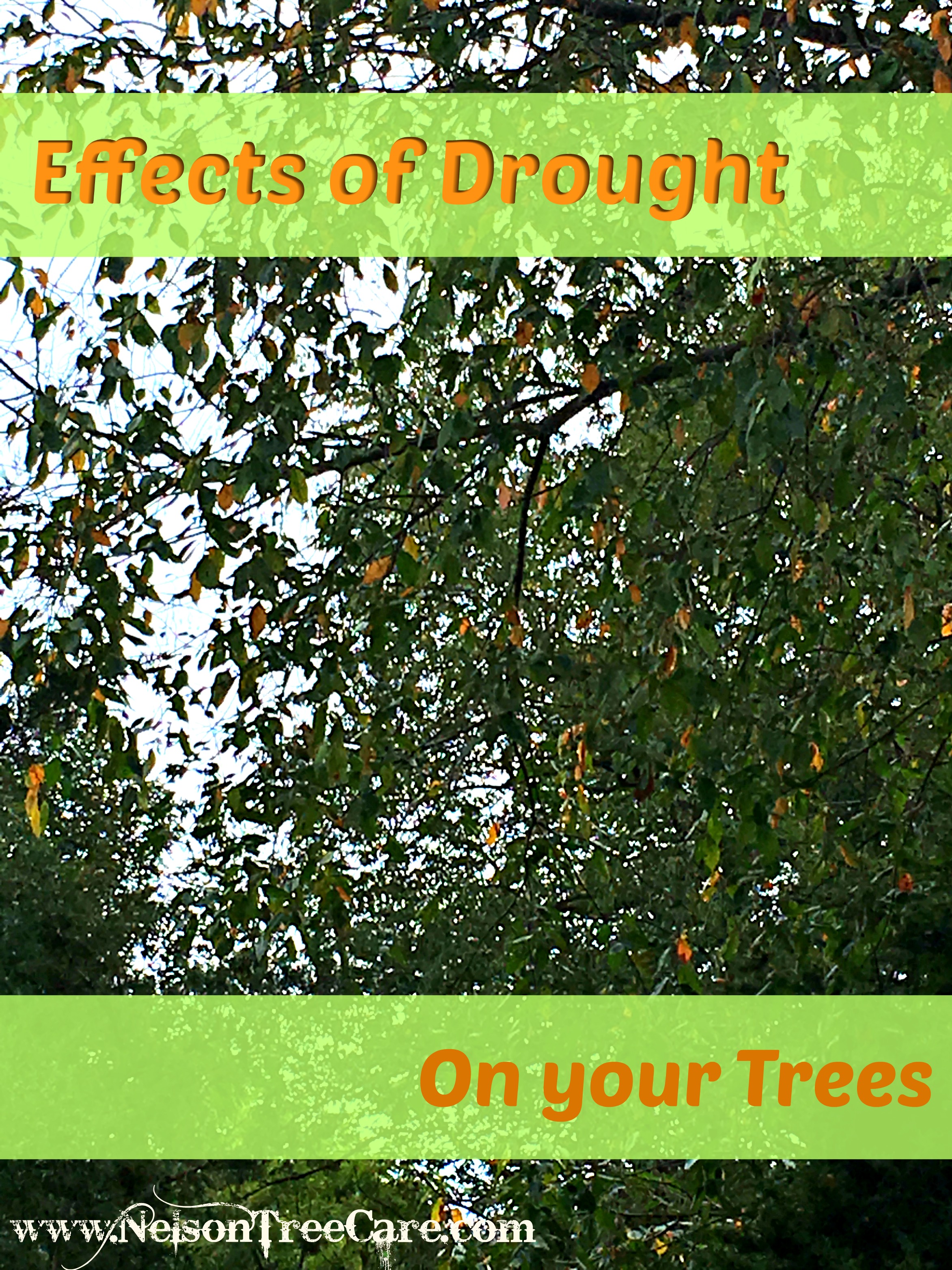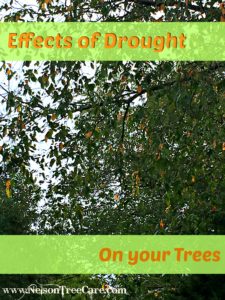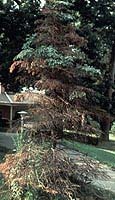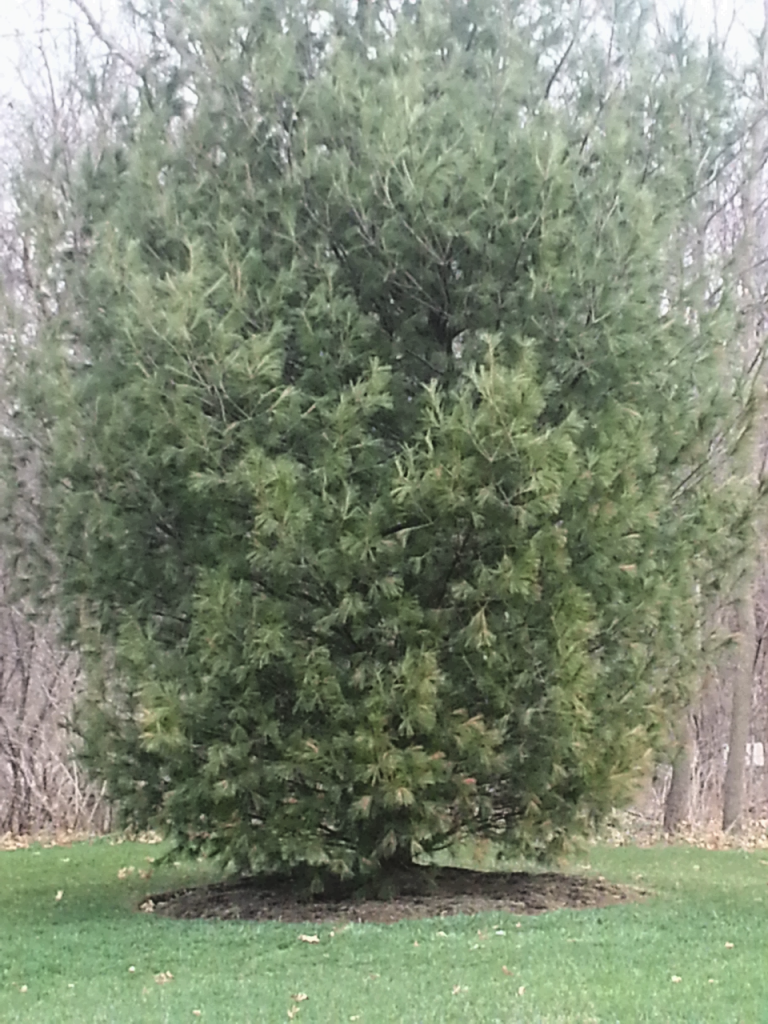

Here in Northern Illinois, we have been experiencing crazy weather over the last decade. Between having little rain one year to an abundance the next year, then having extreme winters of heavy snow or subfreezing temperatures, it is a wonder our trees are still standing!
The reason for speaking about the topic of drought is because we are seeing a lot of tell tale signs of the impact of drought in our area, and want to share it with our customers.
Our customers usually notice their tree is lacking water when the leaves start to wilt, dry out, or fall off. Most people are under the assumption that trees have deep tap roots that extend way down into the ground to feed themselves when there is no rain. This is simply untrue- most feeder roots that take water into the tree are found within the top 12″ of soil, so the less rain we get, the less water is going deeper down, and the less water the trees are getting. Also, when there is grass growing around the trees, that grass is taking the majority of water before the tree roots get a chance to drink!
For more info on trees and water requirements, please visit our post “Are Your Trees Dying of Thirst”
SHORT TERM DROUGHT EFFECTS ON TREES
First, what is a drought? Drought is a ‘period of below-average precipitation in a given region, resulting in prolonged shortages in its water supply, whether atmospheric, surface water or ground water.’ ~ Wikipedia To monitor whether your region is experiencing drought, visit this site. Keep in mind, that just because a city or region has had it’s normal amount of precipitation for the month, it does not mean that that area isn’t in a drought. There could be one or two instances of rain in that month, which fulfills it’s monthly quota, but does not keep the tree adequately watered the rest of the month.
With plants, it’s easy to see that they need water, because the leaves begin to wilt. That is not the case with trees that are mature. Their need for water isn’t as expressly implied like a plant’s, since they are a bigger organism, it takes longer for the effects to be seen. Just like plants, trees pull moisture from the ground up to their canopy. When moisture is lacking in the ground, those fine feeder roots will dry up and die.

Fine Feeder Roots
This photo shows an example of a trees’ fine feeder roots. As you can see, a tree has many roots under the soil which help aid in nutrient and water transportation. During times of drought, it is these feeder roots that dry up and die. When enough of these feeder roots die off, the trees’ ability to feed itself becomes compromised. Water is critical to a tree in order to perform almost all processes within itself including photosynthesis. Photosynthesis- as a refresher of high school biology- is the process used by plants and other organisms to convert light energy into chemical energy that can later be released to fuel the organisms’ activities (energy transformation). ~ Wikipedia When the process of photosynthesis cannot be performed, the tree cannot use or store energy within itself. This is similar to what happens during dormancy, but it should not occur during it’s growing season! Also, when a tree is unable to perform photosynthesis, it cannot produce carbohydrate stores within itself. Carbohydrates “are important components of hormones and secondary metabolites. Secondary metabolites, including tannins and alkaloids, are used in plant defense against insects and diseases. As their production decreases due to drought, trees become more susceptible to attack by pests and pathogens.” ~ https://www.mortonarb.org/files/Damaging-effects-of-drought.pdf
“Secondary metabolites are responsible for many of the defense mechanisms a plant needs to thwart infectious diseases and certain insect attacks. These metabolites include oleoresins, tannins and alkaloids. Initially, there may be an increase in the production of secondary metabolites in drought stressed plants as carbohydrates are redirected to the synthesis of these products. However, as the severity of drought persists, the amount of secondary metabolites decreases and plants become vulnerable to secondary attacks by certain insects and diseases.” –https://ag.umass.edu/fact-sheets/long-term-drought-effects-on-trees-shrubs
In other words, when a tree shuts down production during a growing season, it looses it’s ability to ward off insect and disease attacks since it’s system is weakened.
To sum, the short term effects of drought on a tree are, wilting of leaves, loss of feeder roots, loss of energy stores within the plant, and a weakening of it’s system which can bring about insect and disease problems. You may also see early leaf coloring and drop such as in the first picture above which was showing color change in August as a result of drought.
LONG TERM EFFECTS OF DROUGHT
While it is sometimes easy to see that a tree is experiencing the effects of drought in a given year, sometimes, these go unnoticed to most homeowners. While it’s easy to spot that your plants need water, or your grass, most people don’t really think their trees need water unless they are young trees and can show you that they are stressed. When your trees go through an extensive drought (like this year- 2016- in Richmond, IL) or multiple periods of drought in successive years, you will start to notice tell tale signs of the damage that has been done. Some of these signs are branch dieback, tree death, or disease presence.

The diseases that will occur as a result of drought are Root Rots, Cankers, Wood Rots, and Wilt. Specific examples include Armillaria Root Rot, Nectria Canker, Cytospora Canker (shown left), Rhizospharae NeedleCast, and Diplodia Tip Blight. (https://ag.umass.edu) These diseases stem from stress within the trees environment which is most generally a result of drought or winter damage. When your tree is not stressed and healthy, it can localize the pathogens of the disease within itself so that it does not overtake the tree. However, during times of stress, the disease will prevail since the tree does not have the reserved energy to fight back.
CARING FOR YOUR TREES DURING A DROUGHT
The Morton Arboretum has a couple of tips to help your trees during times of drought or dry spells.
- WATER! Check the soil around your trees to a depth of 6″. If the soil is dry or getting dry, make sure you do a deep soaking to get water down to that depth. Keep in mind, running a sprinkler on the area for an hour is probably not going to reach that depth. Also, make sure you are soaking the whole area up to the drip line of the tree (where the canopy spreads out to.)
- MULCH! Apply a good 3″ layer of mulch around the tree’s base to it’s drip line (don’t go more than 3-4″ deep, and keep the mulch away from the trunk of the tree so that moisture doesn’t sit right against the trunk and cause fungus and decay!) This will keep the soil moist longer under the mulch, and prevent the soil from drying out as quickly. You may need to soak a bit longer, however, to make sure that you are penetrating both the mulch and soil.
- NO NITROGEN FERTILIZERS DURING DROUGHT!! Nitrogen is designed to give your tree a quick growth cycle, and many fertilizers contain salt. The salt will only make your tree dry out faster, and getting a tree to go into a quick growth cycle when it is shutting down will only put added stress on the tree.
- PRUNING! Make sure that you remove any dead or diseased branches from your trees so that you can minimize problems with any pests or pathogens that may use these branches as an entry to your tree. ~ https://www.mortonarb.org/files/Damaging-effects-of-drought.pdf
OTHER RECOMMENDATIONS
We also recommend using an organic deep root “fertilizer” or compost tea during times of drought. These products have the addition of mychorrizae which are beneficial fungi that attach themselves to the roots of your trees to help them absorb water and nutrients more fully from the soil. This is especially important during times of drought as these fine roots are damaged and destroyed, so these fungi will help in repairing those roots to once again function. Another beneficial ‘arborceutical’ is a plant growth regulator. These work to increase the root system of the tree while minimizing the canopy growth. This helps during times of drought because the leaves are thicker and they are not as large once the treatment is done, which minimizes water loss. The roots are then able to provide the tree with reserves longer through any extensive dry spells.
 As shown in the picture to the left, when a tree is properly fertilized and mulched, it can withstand stresses and remain healthy even during times of heavy disease or insect presence.
As shown in the picture to the left, when a tree is properly fertilized and mulched, it can withstand stresses and remain healthy even during times of heavy disease or insect presence.
While the drought during a given year may not lead to the death of the tree, the long term effects may not be seen for a couple of years. Keep in mind, trees can experience drought during the winter as well when snowfall is minimal or a deep frost occurs that prevents the trees from absorbing the snowmelt prior to evaporation. Keeping an eye on your trees health, and monitoring them frequently for moisture in the soil during dry spells is crucial to their success.
Please feel free to contact us with any questions or concerns you may have regarding your trees, or to set up a consultation to check the status of your trees as well!


